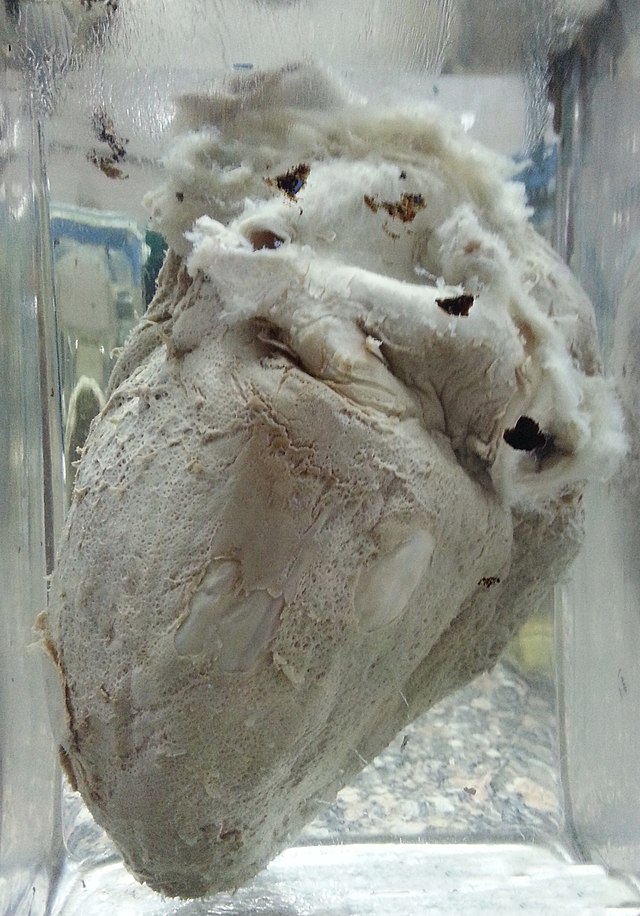Constrictive pericarditis
Hardening of the membrane surrounding the heart From Wikipedia, the free encyclopedia
Constrictive pericarditis is a condition characterized by a thickened, fibrotic pericardium, limiting the heart's ability to function normally.[1] In many cases, the condition continues to be difficult to diagnose and therefore benefits from a good understanding of the underlying cause.[2]
| Constrictive pericarditis | |
|---|---|
| Other names | Pericarditis - constrictive[1] |
 | |
| Constrictive pericarditis is defined by a fibrotic (thickened) pericardium. | |
| Specialty | Cardiology |
| Symptoms | Fatigue[1] |
| Causes | Tuberculosis, Heart surgery[1] |
| Diagnostic method | CT scan, MRI[1] |
| Treatment | Diuretic, Antibiotics[1] |
Signs and symptoms
Signs and symptoms of constrictive pericarditis are consistent with the following: fatigue, swollen abdomen, difficulty breathing (dyspnea), swelling of legs and general weakness. Related conditions are bacterial pericarditis, pericarditis and pericarditis after a heart attack.[1]
Causes
The cause of constrictive pericarditis in the developing world are idiopathic in origin, though likely infectious in nature. In regions where tuberculosis is common, it is the cause in a large portion of cases.[3] Causes of constrictive pericarditis include:
- Tuberculosis[4]
- Incomplete drainage of purulent pericarditis[4]
- Fungal and parasitic infections[4]
- Chronic pericarditis[4]
- Postviral pericarditis[4]
- Postsurgical[4]
- Following MI, post-myocardial infarction[4]
- In association with pulmonary asbestos[5]
Pathophysiology

The pathophysiological characteristics of constrictive pericarditis are due to a thickened, fibrotic pericardium that forms a non-compliant shell around the heart. This shell prevents the heart from expanding when blood enters it. As pressure on the heart increases, the stroke volume decreases as a result of a reduction in the diastolic expansion in the chambers. [6] This results in significant respiratory variation in blood flow in the chambers of the heart.[7]
During inspiration, pressure in the thoracic cavity decreases but is not relayed to the left atrium, subsequently a reduction in flow to the left atrium and ventricle happens. During diastole, less blood flow in left ventricle allows for more room for filling in right ventricle and therefore a septal shift occurs.[8]
During expiration, the amount of blood entering the left ventricle will increase, allowing the interventricular septum to bulge towards the right ventricle, decreasing the right heart ventricular filing.[9]
Diagnosis
Summarize
Perspective

The diagnosis of constrictive pericarditis is often difficult to make. In particular, restrictive cardiomyopathy has many similar clinical features to constrictive pericarditis, and differentiating them in a particular individual is often a diagnostic dilemma.[10]
- Chest X-Ray - pericardial calcification (common but not specific), pleural effusions are common findings.[11]
- Echocardiography - the principal echographic finding is changes in cardiac chamber volume.[11]
- CT and MRI - CT scan is useful in assessing the thickness of pericardium, calcification, and ventricular contour. Cardiac MRI may find pericardial thickening and pericardial-myocardial adherence. Ventricular septum shift during breathing can also be found using cardiac MRI. Late gadolinium enhancement can show enhancement of the pericardium due to fibroblast proliferation and neovascularization.[9]
- BNP blood test - tests for the existence of the cardiac hormone brain natriuretic peptide, which is only present in restrictive cardiomyopathy but not in constrictive pericarditis[12]
- Conventional cardiac catheterization[13]
- Physical examination - can reveal clinical features including Kussmaul's sign and a pericardial knock.[13]
Treatment
The definitive treatment for constrictive pericarditis is pericardial stripping, which is a surgical procedure where the entire pericardium is peeled away from the heart. This procedure has significant risk involved,[14] with mortality rates of 6% or higher in major referral centers.[15]
A poor outcome is almost always the result after a pericardiectomy is performed for constrictive pericarditis whose origin was radiation-induced, further some patients may develop heart failure post-operatively.[16]
References
Further reading
External links
Wikiwand - on
Seamless Wikipedia browsing. On steroids.
